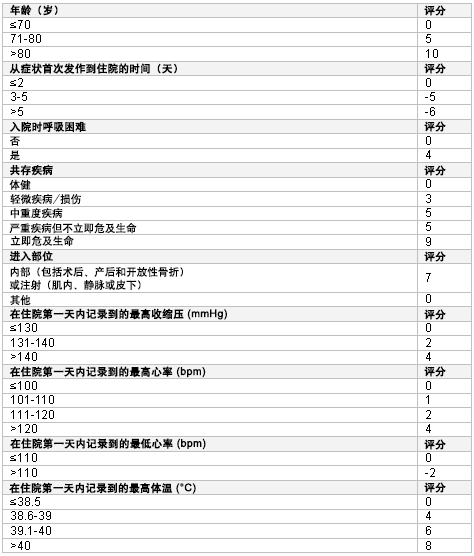病死率为 12%-53%。[72]Thwaites CL, Yen LM, Glover C, et al. Predicting the clinical outcome of tetanus: the tetanus severity score. Trop Med Int Health. 2006;11:279-287.http://onlinelibrary.wiley.com/doi/10.1111/j.1365-3156.2006.01562.x/fullhttp://www.ncbi.nlm.nih.gov/pubmed/16553907?tool=bestpractice.com 在有机械通气设备的机构,最常见的死因是自主神经功能障碍和医院获得性肺炎。在不允许进行机械通气的机构,最常见的死因是窒息,由喉部痉挛、呼吸肌痉挛和极度疲劳导致。[12]Thwaites CL, Farrar JJ. Preventing and treating tetanus. BMJ. 2003;326:117-118.http://www.ncbi.nlm.nih.gov/pmc/articles/PMC1128865/http://www.ncbi.nlm.nih.gov/pubmed/12531822?tool=bestpractice.com
迅速诊断和严重程度预测至关重要,有助于确定及时处理方法,包括转诊至重症监护病房和早期气道保护。这有助于首选处理严重疾病的危及生命的并发症。
严重疾病和结局不良的预测因素如下:
潜伏期(自受伤至首次出现症状)长短与疾病的严重程度呈负相关。据说潜伏期少于 7 天的疾病可预测 3b 级疾病。[1]Ablett JJL. Analysis and main experiences in 82 patients treated in the Leeds Tetanus Unit. In: Ellis M, ed. Symposium on tetanus in Great Britain. Boston Spa, UK: National Lending Library; 1967.
发病期(首次出现症状至首次痉挛)也与疾病严重程度呈负相关。
感染部位:脐带、子宫、头部和颈部感染预示严重疾病。
据报告,肌内注射奎宁的死亡率为 96%。[21]Yen LM, Dao LM, Day NP, et al. Role of quinine in the high mortality of intramuscular injection tetanus. Lancet. 1994;344:786-787.http://www.ncbi.nlm.nih.gov/pubmed/7916074?tool=bestpractice.com 经常使用奎宁来”削减“或稀释海洛因,这可能会导致破伤风吸毒者有更高的死亡率。[44]Attygalle D, Rodrigo N. New trends in the management of tetanus. Expert Rev Anti Infect Ther. 2004;2:73-84.http://www.ncbi.nlm.nih.gov/pubmed/15482173?tool=bestpractice.com
共病。
年龄过大或过小。[3]Roper MH, Vandelaer JH, Gasse FL. Maternal and neonatal tetanus. Lancet. 2007;370:1947-1959.http://www.ncbi.nlm.nih.gov/pubmed/17854885?tool=bestpractice.com
自主神经功能障碍。
缺乏免疫力。即使先前未经受完全免疫,也与病情较弱相关。[3]Roper MH, Vandelaer JH, Gasse FL. Maternal and neonatal tetanus. Lancet. 2007;370:1947-1959.http://www.ncbi.nlm.nih.gov/pubmed/17854885?tool=bestpractice.com
许多团队设计了评分系统来判断破伤风的预后。Phillips 评分根据潜伏期、感染部位、免疫状态和复杂化因素来评估严重性指数。[73]Phillips LA. A classification of tetanus. Lancet. 1967;1i:1216-1217.http://www.ncbi.nlm.nih.gov/pubmed/4165144?tool=bestpractice.com Dakar 评分根据潜伏期、发病期、受伤部位以及入院时是否出现肌痉挛、发热和心动过速进行评估。[74]Vakil BJ. Table ronde: propositions pour une classification internationale. In: 4th International Conference on Tetanus, vol 1. Dakar, Senegal: Fondation Merieux; 1975:3349-3367. 一项研究连续纳入 1997 年 5 月至 1999 年 2 月期间到热带疾病医院(越南胡志明市)破伤风病房接受治疗的 500 例患者(非新生儿),发现 Dakar 评分 3 分及以上的患者死亡率为 59%,而 3 分以下的患者死亡率仅为 14%。Phillips 评分 17 分及以上的患者死亡率为 34%,17 分以下的患者死亡率为 11%。
已设计出一项新的破伤风严重程度评分系统,通过使用从连续到热带疾病医院(胡志明市)入院的患者中收集到的前瞻性数据,采用多变量逻辑回归分析法进行设计的。[72]Thwaites CL, Yen LM, Glover C, et al. Predicting the clinical outcome of tetanus: the tetanus severity score. Trop Med Int Health. 2006;11:279-287.http://onlinelibrary.wiley.com/doi/10.1111/j.1365-3156.2006.01562.x/fullhttp://www.ncbi.nlm.nih.gov/pubmed/16553907?tool=bestpractice.com 笔者将其最新评分系统与 Phillips 和 Dakar 评分系统(已发行 30 余年,但仍无验证数据)进行了比较。在使用再替代数据进行检测时,依据破伤风严重程度评分,判断致命性结局的敏感性为 77%,特异性为 82%,与 Phillips 和 Dakar 评分系统相比,其对存活者与非存活者有显著更好的辨识度。
在新生儿破伤风患者中,年龄小于 10 天、潜伏期为 6 天或更短、存在痉笑、角弓反张、发热和体重小于 2.5 kg,提示预后不良和死亡高风险。[75]Gurses N, Aydin M. Factors affecting prognosis of neonatal tetanus. Scan J Infect Dis. 1993;25:353-355.http://www.ncbi.nlm.nih.gov/pubmed/8362232?tool=bestpractice.com[76]Davies-Adetugbo AA, Torimiro SE, Ako-Nai KA. Prognostic factors in neonatal tetanus. Trop Med Int Health. 1998;3:9-13.http://onlinelibrary.wiley.com/doi/10.1046/j.1365-3156.1998.00162.x/fullhttp://www.ncbi.nlm.nih.gov/pubmed/9484962?tool=bestpractice.com[77]Basu S, Paul DK, Ganguly S, et al. Risk factors for mortality from neonatal tetanus: 7 years experience in North Bengal, India. Ann Trop Paediatr. 2006;26:233-239.http://www.ncbi.nlm.nih.gov/pubmed/16925961?tool=bestpractice.com [Figure caption and citation for the preceding image starts]: 破伤风严重程度评分。最终得分为每个小项得分的总和。总分为 8 分或更高提示死亡;低于 8 分提示幸存摘自 Thwaites CL, Yen LM, Glover C, et al. Predicting the clinical outcome of tetanus: the tetanus severity score. Trop Med Int Health. 2006; 11: 279-287 [Citation ends]. 一项针对越南 107 例新生儿破伤风的研究证实了低龄和低体重与不良结局的相关,而入院延迟和出现白细胞增多是重要额外因素。[78]Lam PK, Trieu HT, Lubis IN, et al. Prognosis of neonatal tetanus in the modern management era: an observational study in 107 Vietnamese infants. Int J Infect Dis. 2015;33:7-11.http://www.ncbi.nlm.nih.gov/pmc/articles/PMC4396701/http://www.ncbi.nlm.nih.gov/pubmed/25499039?tool=bestpractice.com
[Figure caption and citation for the preceding image starts]: 破伤风严重程度评分。最终得分为每个小项得分的总和。总分为 8 分或更高提示死亡;低于 8 分提示幸存摘自 Thwaites CL, Yen LM, Glover C, et al. Predicting the clinical outcome of tetanus: the tetanus severity score. Trop Med Int Health. 2006; 11: 279-287 [Citation ends]. 一项针对越南 107 例新生儿破伤风的研究证实了低龄和低体重与不良结局的相关,而入院延迟和出现白细胞增多是重要额外因素。[78]Lam PK, Trieu HT, Lubis IN, et al. Prognosis of neonatal tetanus in the modern management era: an observational study in 107 Vietnamese infants. Int J Infect Dis. 2015;33:7-11.http://www.ncbi.nlm.nih.gov/pmc/articles/PMC4396701/http://www.ncbi.nlm.nih.gov/pubmed/25499039?tool=bestpractice.com
 [Figure caption and citation for the preceding image starts]: 破伤风严重程度评分。最终得分为每个小项得分的总和。总分为 8 分或更高提示死亡;低于 8 分提示幸存摘自 Thwaites CL, Yen LM, Glover C, et al. Predicting the clinical outcome of tetanus: the tetanus severity score. Trop Med Int Health. 2006; 11: 279-287 [Citation ends]. 一项针对越南 107 例新生儿破伤风的研究证实了低龄和低体重与不良结局的相关,而入院延迟和出现白细胞增多是重要额外因素。[78]
[Figure caption and citation for the preceding image starts]: 破伤风严重程度评分。最终得分为每个小项得分的总和。总分为 8 分或更高提示死亡;低于 8 分提示幸存摘自 Thwaites CL, Yen LM, Glover C, et al. Predicting the clinical outcome of tetanus: the tetanus severity score. Trop Med Int Health. 2006; 11: 279-287 [Citation ends]. 一项针对越南 107 例新生儿破伤风的研究证实了低龄和低体重与不良结局的相关,而入院延迟和出现白细胞增多是重要额外因素。[78]